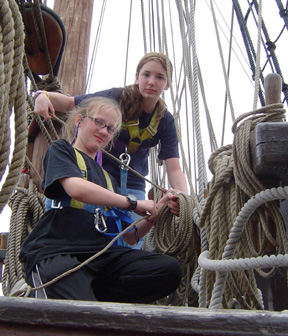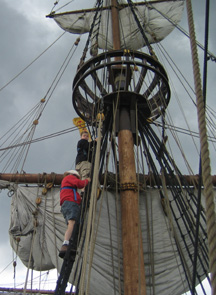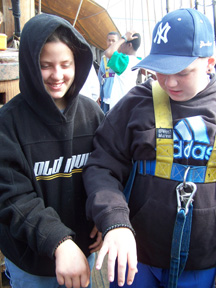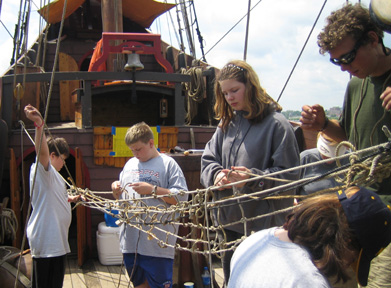 |
|
Shipcraft |
|
|
|
Quicklinks Rope Handling |
During our time on the Hudson River, we maintain and operate the Half Moon much like Captain Hudson and his crew would have during their Voyage of Discovery in 1609. Our young crews spend a week fully immersed in 17th century ship life, with every part of the ship teaching different skills.
|
|
Rope Handling
Operating the Half Moon utilizes nearly three miles of rope, with every line performing a specific task. Thus, "learning the ropes" is one of the first challenges for any new crewmember -- and one of the most important.
Operating the ship's lines can be extremely complex, but it begins with a very simple step: Students first learn how to belay lines on the pin rail, and then how to properly coil them to keep them tidy. When we work the sails, so many lines are in use that if the crew doesn't work to keep them neat and organized, they lines can rapidly turn into an unworkable tangle.
|
|
Sail Handling
With the basic line handling skills under their belt, the students are soon ready to learn how to sail the Half Moon. In a sense, each mast works like a giant marionette. Students quickly discover how to work these puppets, hauling or releasing lines to manipulate the yards and sails and thus catch the wind. Fortunately, we had ideal weather on this Voyage of Discovery and were able to enjoy several days of sailing. |
|
Working in the RigAn exciting opportunity for every crew member onboard the Half Moon is to climb high above the weatherdeck and work in the rig. However, safety is always our first concern onboard the Half Moon. Before anyone is allowed to climb the shrouds (the black, ladder-like rigging to either side of the masts, visible below), they must learn the proper methods of donning and using a safety harness. To the right, Captain Washington shows Jamal how to tighten a harness for a snug, secure fit. |
|
Even when the students are trained in the use of a safety harness, they still face one more challenge before they can be cleared to climb the rigging. Under close adult supervision, our new crew members climb a few feet above the deck and perform a "hang test," hanging just by their hands for a few seconds. This lets us know that the climbers can support their own weight, and lets them know how tightly they need to grip the shrouds to maintain their hold just in case they ever slip. They also learn the importance of "three-point contact," which ensures that if one of their limbs (either a hand or foot) ever does lose its grip, they'll still have at least two more supporting them at all times.
No one is required to climb the rig, and in fact over the years we've had many valuble crew members onboard whose feet always stay on deck. However, most new crew members consider climbing the rig to be a major accomplishment and point of pride. |
|
High in the rigging, students help work the top sails and furl the sails (lashing the sails to the yards when they're not being used to prevent the wind from snarling them). |
|
Sometimes, a crew member even has to climb up past the "top" (the structure often mistakenly called a crow's nest, visible to the right) all the way to the very top of the mast (known as the truck) -- but this is always a job for the adult crew. Here, Mr. Dawson has just scaled the main mast to free a flag that had wrapped around itself and snagged during a day of sailing.
|
|
Marlinspike
|
|
Marlinspike is the art of rope use, which comes in many different forms onboard the Half Moon. During the 17th Century, sailors who weren't actively working on more pressing duties would spend much of their time crafting and repairing gear for the ship, including sails, ropes, and all manner of tools -- every element of the ship needed constant upkeep. This tradition continues today on the modern Half Moon. Many of the tools we use onboard, including canvas buckets and covers and leather knife sheathes, have been hand-crafted by past and present crew members, both students and adults. During this voyage, Captain Berg took the initiative, leading the students through several creative projects that made use of their new maritime skills. These craftwork projects included bracelets (left) and a working hammock (right). (Click here to see the hammock in action.) |
|
A crucial skill for any mariner is the ability to read a chart or map. Students onboard the Half Moon learn how to use a chart and compass to triangulate their position on the Hudson River. On this particular Voyage of Discovery, the students also applied these skills to mathematical challenges, using river charts to measure distance, then comparing it to our average speed to accurately predict our arrival times. Students were also able to use our modern river charts, a Dutch chart from the 17th Century, and a photographic diorama book from the early 20th Century to compare records of the Hudson river from three separate centuries. |
|
Working in the Galley |
|
|
It may not be the most glamorous aspect of ship life, but the role of "ship's cook" is absolutely one of the most vital. Both in 1609 and today, captains know that a well-fed crew is a hard-working crew. (A lesson Henry Hudson himself learned too late.) Every student spends time in the galley as part of their regular duty roster, acting as an assistant under the professional tutiledge of our cook, Rosemary Barton. Using just the limited resources of a small (modern) galley, preparing three tasty and nutritious meals a day for more than twenty crew members (and then cleaning up afterward) isn't just a job -- it's a major organizational challenge. After a week in our galley, students come away with valuable lessons in time management -- and sometimes, having discovered some cooking talent as well. |
|



